A cellar
Contact: email daveclarkecb@yahoo.com
This page created 2006/08/18, modified 2009/06/26
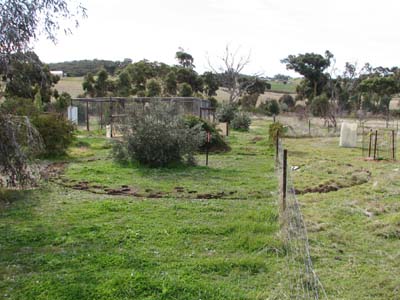
| |
The circle marked on the ground shows where the excavation for the cellar
is to be dug.
|
|

| |
Digging a drain to prevent the cellar from flooding. The drain will carry
water from the pit surrounding the cellar down the natural hill slope.
This excavator also dug the pit.
|
|

| |
The pit after excavation. It is 10m in diameter, 1.7m deep on the left and
1.1m deep on the right because of the natural slope of the ground. The
excavator dug the 28 cubic metre pit in about 2½ hours; the weight
of the soil and rock removed would have been about 60 tonnes.
|
|
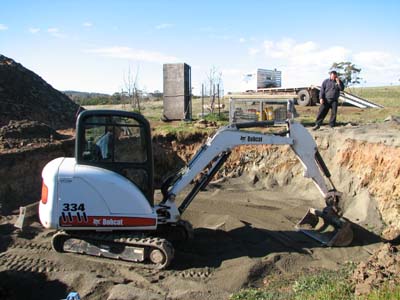
| |
Mini-excavator preparing a firm and flat base for pouring the concrete floor
of the cellar. Something like ten tonnes of 'scalpings' were used to provide
the base. Wet, plastic, clay was removed before placing the scalpings.
|
|

| |
The inner form for the walls, some of the steel reinforcing, and the form
for the doorway
|
|

| |
The supports for the roof; left in place while the concrete set. Only the
large, centre, column remained permanently.
|
|

| |
The concrete part of the cellar completed
|
|
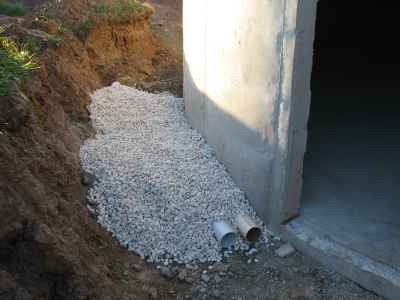
| |
The gravel and the left pipe (which is perforated)
are to drain water from the earth abutment to stop it from becoming
waterlogged and collapsing. The right pipe takes water from the cellar
door down the drain trench (see photo below).
|
|
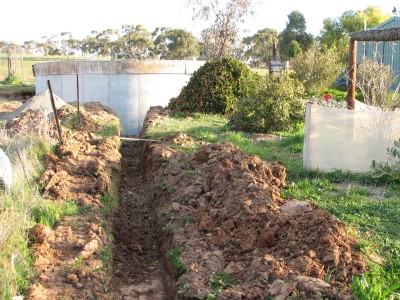
| |
The drain trench. A 100 mm diameter pipe in this trench will take storm
water and water seeping from wet earth away from the cellar pit.
|
|

| |
Bobcat backfilling the excavation around the cellar
|
|

| |
Retaining walls were built using some of the stones from the excavation.
A little of the gravel bed and the ends of the drain pipes can just be
seen at the bottom of the retaining wall.
Not visible in this photo is a ventilator near the blue drum on the extreme
right. The shade cloth is over the door opening because the door was not
in place when this photo was taken.
The first of the mulch can be seen on the roof. More mulch and earth was
added later. The roof area was planted with ground covers and melons
soon after this photo was taken.
|
|

| |
A view of the interior when the cellar has been partly furnished
|
|

| |
The wooden door, made by a local carpenter and builder.
|
|
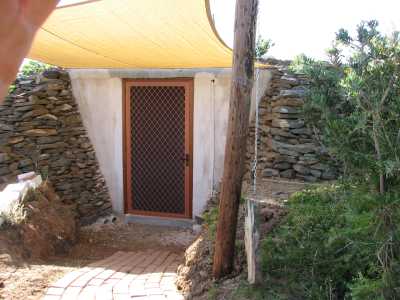
|
After having the doors built and fitted.
The shade sail is to keep the hot summer sun off the NW facing door and
wall. This is the only part of the cellar walls that is exposed to the
weather.
All the roof is covered with soil; more soil was added after this photo
was taken.
Vaulted entrance
The temperature in the cellar could be kept more constant year-round by
building a vaulted porch with inner and outer doors.
I believe, but cannot prove, that most heat comes and goes through the
door and the part of the wall exposed at the front.
A vaulted entrance would also improve the appearance, but
considerably add to the cost.
|
|

| |
Sunlight streaming through the door and (slightly and slowly) warming the
cellar in winter.
The afternoon sun in winter is at just the right angle to shine through
the screen door.
I'd like to say that I planned the cellar this way, but I'd be telling a
lie; the door was placed in that position for convienience of entry, it
was just luck that it was the ideal direction to catch the winter's
sun.
|
|

| |
The cellar as seen from up-slope, 2009/03/25.
The nearer part of the mound is covered with dusky corral-pea
(Kennedia nigrens), and the far side mostly with creeping boobialla
(Myoporum parvifolium).
Barely visible at right of centre is the spinning ventilator.
At this time most of the cellar roof had 25 to 30cm of soil cover.
|
|
The notes on this page are mainly about a cellar that I built in the
'Mid North' of South Australia.
I have written
them in the hope that they might be of some use to others who are
contemplating building a cellar. I would like to have been able to read
about other people's experiences before building my cellar, it might have
made my job easier.
These notes also provide a record for me, and I enjoy writing.
Refuge from bushfire
I am not an expert in bushfires.
Before building a cellar as a refuge you might be wise to discuss the
matter with someone who has had experience in the field.
Following the Victorian bushfires of February 2009,
in which more than a hundred people were
killed, it's worth stressing that a cellar is not just a refuge from
summer heat, it is also available as an excellent refuge from bushfires.
Both heat and bushfires are going to be more common with
climate change; perhaps even more importantly,
days of fire danger levels even greater than what has been known as
'extreme' are likely.
It would be important to seriously consider whether your house or other
structures or trees might block your escape from your cellar following a
bushfire.
You would also need to consider the possibility of a wooden cellar door
catching fire and the consiquences of that.
The cellar would have to be the last resort.
Obviously you wouldn't be able to protect your house while you were
taking refuge in a cellar.
Small, simple, fire refuge?
It would not be necessary to build a big cellar like the one discussed on
this page, something much smaller and simpler could be used.
It would be sufficient to dig a hole about 2m diameter, line it with
bricks or stone and put a reinforced concrete slab on top with a steel
hatch in it.
Cover most of the slab with a little soil.
You'd need a ladder beneath the hatch, and before you had to use it take
down as many folding chairs as you needed.
The soil would protect the cellar and its occupants from the radiant
heat of the fire.
There would be radiant heat from the steel hatch, but I suspect that would
not be dangerous in the short time involved.
If there was any possibility of having trees or limbs fall on top of the
cellar then it would be as well to put a steel tripod-frame over the top to
ensure that they could not block the hatch and stop you from being able
to get out.
Such a simple cellar will probably fill up with water in a wet period,
but the water would almost certainly be long gone before any bad fire.
An option, if the land was sloping, would be to put in a drain from the
bottom of the cellar to a lower point on the hillside.
In Australia it is possible to buy ready-made concrete cellars that need
only be placed into a hole in the ground and then have earth replaced
around them. These are quite expensive and are very heavy and therefore
expensive to transport from the point of manufacture to the point of
installation. They do not seem generally to be designed for covering with
a significant depth of earth (needed for good insulation).
Access is by steps via a hole in the roof
of the cellar, so some structure to protect
the top of the stairway from the weather must be built over the cellar.
It seems to me that these cellars would be best when placed beneath a new
house before construction of the house itself.
It is also possible to build a very simple cellar by simply burying a
shipping container.
It is questionable how long the walls and roof of the
container would withstand the pressure from the soil, and the steel would
probably rust very quickly, especially in areas with relatively high
rainfalls and acid soils (such as in my case).
I seriously considered using a
shipping container and various methods to control rusting and protect the
container from soil pressure, but finally gave up the idea as impractical.
Some cellars are based on a concrete tank built on site
in an excavation and then covered with soil, as is mine.
These notes
deal primarily with a 90 cubic metre cellar set into an excavation and
covered with mulch and soil.
The big excavator (shown digging the drain in one of the photos on the right)
dug the pit in two and a half hours. I could not have dug it by hand if I
had devoted two and a half months to the work! Some of the sixty tonnes of
earth and rock removed was rock that was so hard that I could make little
impression on it with a heavy crowbar.
The total cost of earthmoving was only about 5% of the total cost of
constructing the cellar. I suspect that the cost of earthmoving will prove
to be closely tied to the cost of fuel, and will rise substantially in the
future. However, even if it doubles that will still bring it up to only
about 10% of the total cost of cellar building.
All contractors, other than the one who did the concreting work,
were based in the Clare Valley. (The concreting was specialised.)
The main hole and most of the drain was dug by S.C. Heinrich using the
big excavator shown digging the drain in the photo at the right.
The tidying-up of the hole and the spreading of the base gravel was done by
Mark Harrold's mini-excavator also shown in a photo on the right.
The concrete part of this cellar was built by Adelaide Hills Concrete Tanks,
PO Box 902 Strathalbyn 5255, South Australia. Phone 08 8391 2013,
mobile 0408 365 551. It is covered by a twenty year written
guarantee.
Electrical wiring was done by David Bond.
The doors were built and installed by Craige Lloyd (Vision Builders), Blyth.
08 8844 5180, mobile 0419 188 089.
The contractors had no input into this Internet page and I have no financial
arrangements with any of the contractors apart from the building of this
cellar.
Another South Australian specialist in building concrete cellars is
Hyteck Concrete Products,
Paringa, phone 08 8595 5266, mobile 0414 812 220.
In Clare (Mid-North South Australia) the winters are cold enough for some
form of heating to be needed and the summers are hot enough for
cooling to be necessary for comfort. Just a metre below the houses that
are consuming energy for heating and cooling the temperature of the subsoil
or rock is a constant and comfortable temperature all year around.
I measured the temperature in two wells on my place and found it to be 18
degrees Celsius in both.
Conservation of energy is becoming more and more important because of
greenhouse and
the declining petroleum supply.
In South Australia electricity for running air conditioning (home cooling) is
at its least
reliable when needed most: in periods of exceptional heat, simply because
the supply system is then under its greatest load.
Also, because the greatest fire hazard occurs on exceptionally hot and
windy days, and because power lines can cause fires on such days, the
electricity supply is sometimes switched off then.
Using a cellar as a
means of staying cool not only avoids the problem of unreliable electrical
supply for the user, but also helps to reduce the cause of the problem:
peak demand. So from the point of view both of the user of the cellar and
those running the electrical grid, cellars are a good way of staying cool.
As I write this I suspect that Western societies are facing a long
depression brought on by the declining petroleum supply and consequent
steep rise in the cost of energy, especially the energy that we have used
for transport. If this is so, then any increase in one's level of
self-sufficiency,
and independence from the electricity grid,
must be a good thing.
A cellar, such as this one, is a safe refuge from
bushfires.
While the principle of the cellar is simple, there are many practical
complications in cellar construction.
This cellar is about 7.4m diameter and 2.1m high inside, with an internal
volume of 90 cubic metres. The concrete roof weighs about 15 tonnes and
a layer of soil 20cm thick over this would weigh an additional 15 tonnes.
The whole cellar must be made to safely handle these weights.
As the cellar is mostly below ground level it must be able to keep out the
water that will saturate the surrounding soil in a wet winter, and any
storm water run-off.
This particular cellar, being basically a water tank,
keeps water out very well; as of 2009/06/26 I have had it almost three
years, and have not seen any indication of leakage through the concrete.
The round shape resists pressure from the surrounding earth, which is
considerable when it becomes very wet.
Gravel beds and perforated pipes were laid for three metres beneath each
abutment to stop the earth near the abutments from becoming waterlogged
and slumping (see photos).
A 100mm drain pipe takes water from the excavation near the cellar
door down a trench to a lower point on the hill slope (see photos).
It is used for a constant temperature store for garden produce, wine
and olive oil, as a computer room, a bedroom, and a living room.
It is a place to escape the heat of summer.
It may be used for wine making at some time in the future.
| Advantages | Disadvantages |
|---|
- Maintains a temperature with gradual seasonal variations
and very little variation during a single day;
- Much more economical than refrigeration if you need a large storage
space at constant temperature for long periods;
- Cellars reduce the need for electricity at times of peak demand
(in exceptionally hot weather),
reducing the peak loads on the electricity grid;
- By not needing heating or cooling, cellars reduce energy consumption
and therefore greenhouse
gas production;
- By reducing energy consumption, cellars make one more
independent
of fuel and electricity supplies;
- Provides a safe refuge from bushfires;
|
- Not well suited for using natural light, although I have found that
sufficient light for many purposes can come from a suitable door
(see note on false skylight);
- The great thermal mass of a cellar, while being its biggest asset, also
means that intentionaly heating and cooling a cellar will be slow;
- The large amount of cement needed to construct a cellar involves the
one-off release of a lot of
carbon dioxide
into the atmosphere (from the
manufacture of the cement). Production of the steel for reinforcing also
involved the release of CO2;
- Keeping soil water, surface run-off and rainwater out of the cellar
needs serious consideration;
|
In the late twentieth century Western world, keeping a building at the
desired temperature has generally been done by energy consuming active
methods.
A cellar (at least in South Australia) stays at a very useful and
comfortable temperature passively, without any energy requirement.
Any intelligent and open-minded person knows that our society must reduce
its production of greenhouse gasses. While making the
cement
that is used
for building a cellar does result in a substantial amount of carbon dioxide
being released into the atmosphere, once constructed the energy saving
over the life of the cellar will far exceed this.
One of the disadvantages of cellars is that they are not well suited to
the use of natural daylight. It is difficult to use natural lighting while
keeping heat from entering or exiting. However, 25 Watts of
compact flourescent lighting, so long
as it is well placed, is quite enough for reading, using a computer, and
many other activities; 25 Watts goes nowhere for heating or cooling.
The great advantage of cellars is in their ability to maintain temperatures
within fairly narrow limits, this is the key point.
About 0.9 tonnes of the greenhouse gas carbon dioxide is released into the
atmosphere for each tonne of cement manufactured.
The 90 cubic metre cellar described on this page
contains about 50 tonnes of concrete and about 5 tonnes of cement,
therefore the resultant amount of carbon dioxide released was about 4.5
tonnes.
This is a substantial amount by any measure.
|
|
The Australian Consumers Association (ACA) in their magazine, Choice, of
November 2007 tested large (claimed 7kW heating and 8kW cooling) split-system
reverse-cycle air conditioners.
They used 3000kWh/yr as the estimated power consumption for both heating
and cooling; 6000kwh/yr total.
This equates to 6 tonnes of CO2 annually if the power is generated in a
coal-fired power station.
As a matter of interest, it seems that the average Australian car is
responsible for releasing about 4.4 tonnes of CO2 annually.
|
|
A coal-fired power station releases about a tonne of carbon
dioxide for each megawatt hour (MWh) of electricity generated, so 4.5 tonnes
of carbon dioxide is released for 4.5 MWh of electricity. A modern
smallish refrigerator uses about 0.5 MWh per year.
Running a 2 kW electric
heater for 3 hours per day 100 days per year would use 0.6 MWh; a
2 kW air conditioner for cooling in summer might also be run about
300 hours per year and would use another 0.6 MWh. These three items
would result in the release of 4.5 tonnes of CO2 in just over two and a half
years.
A concrete cellar should last at least twenty, and quite probably
fifty or a hundred years. Of course a cellar is also capable of keeping many
cubic metres of stores at a fairly constant temperature all year around,
something that would otherwise require a large refrigerated cool-room.
I have not calculated the carbon dioxide associated with the production of
the steel reinforcing used in the cellar. I suspect that it would be less
than that involved with the cement. If any reader has a useful reference on
the matter I would be interested to have it.
I have calculated the greenhouse CO2 that my wife and I are responsible
for releasing in 2006 (including the building of this cellar) at
my CO2 balance.
Notes on the method of construction and the size and shape of my cellar
are given in the section on
Engineering and water matters.
Several other features are significant.
Site
The cellar is built into a gently sloping hillside. The floor of the cellar
is about 1.5m below natural ground level on the upper side and about 1m below
ground level on the lower part of the slope, near the door of the cellar.
The slope of the hill allowed the cellar pit to be drained by natural
flow through a 20m buried drain running down the hill.
Doors
There is only one doorway with two doors. An inner wooden door (which
includes a small hatch for flow-through ventilation) opening inward, and
an outer
screen door opening outward. The doorway has a clear metre's width to allow
moving large items in and out. The door is accessed by a ramp that has a
fall of around a metre.
Flow through ventilation
Opposite the door, in the roof, is a 14cm diameter hole which is capped with
a spinning ventilator. This, together with the small hatch in the door,
provides sufficient ventilation to keep the air fresh inside.
Leaving the wooden door open, but the screen door closed, provides fairly
free ventilation (also see my notes on
temperature control).
Closing the wooden door but leaving its little hatch open provides limited
ventilation. Closing the hatch minimises ventilation.
If I was to start again from the beginning I might add some form of skylight.
A necessary feature of such a skylight would be the ability to close it to
minimise undesired heating from the sun.
Obviously possible entry of rain
water and storm water runoff would also need to be guarded against.
A
skylight
would have to add significant complexity and cost, and with
modern compact fluorescent lights and green electricity, electric lighting
is very cheap and has low environmental impact.
I would also consider ways of increasing ventilation as a way of
temperature control. The ideal might be
a large skylight that can be in any one of four states:
- open to allow
light and ventilation (but screened to keep out vermin);
- open only to light;
- open to ventilation, but closed to light;
- entirely closed.
Light is energy. It therefore will have a heating effect. I do not know
how far it is possible, practicably, to allow in light and keep out radiant
heat (infra red). There would be times when it would be
desirable to have heat from the sun entering the cellar; of course this
is most desirable in winter when the sun doesn't shine a lot.
An extractor fan could be used to maximise air
flow, but has the disadvantage of being noisy and consuming electricity.
Perhaps it is possible to buy quiet extractor fans; if so they could be
useful to force ventilation when one might want to replace excessively
cold air in the cellar in winter with the warmer air of a pleasent
winter's day.
Probably best of all would be to build your cellar first, then your house
on top of your cellar; the roof of the cellar could be integrated into
the floor slab of your house. The cellar could project beyond the house
on one (or more) sides and ventilation and a sky-light could be placed in
the roof of the cellar at that point.
A cheap, environmentally friendly and effective way of lighting a cellar
during daylight hourse would be by using a False Skylight such as that
described in the ReNew magazine issue 108.
The article describes a system that uses a solar panel on the roof powering
several bright light emitting diodes (LEDs) inside.
The writer had built a system with a 10 Watt solar panel and five 3 Watt
LEDs with switching so that all five or only four LEDs would be powered
at any particular time.
No components other than the panel, some simple wiring, a single switch,
and the LEDs was required; the total cost was less than $300.
I have found that my cellar can be cooled by maximising air circulation
when the outside temperature is low and minimising circulation when the
outside temperature is high. I have also found that having the screen door
open provides much more air circulation than having the screen door closed.
Of course entry of moths, mosquitos,
flies and rodents must be considered if the screen
door is to be left open.
(Also see my notes on flow-through-ventilation in the section on
other features of this cellar.)
Leaving the solid door open, and the screen door closed, all of one cool
night might only lower the temperature by a degree, but this is useful as
once cool it does not quickly heat up again.
In winter, when and if the sun shines in the afternoon (not common in
Clare winters), the wooden door can be left open in the afternoon to
allow the sun to shine in and slightly warm the cellar (see photo).
I found that about 25 or 30cm of soil and mulch on the roof, with a
cover of plants, or at least mulch, is sufficient to keep the cellar from
getting above 24 degrees through summer in all but exceptional
heat-waves (it has got to 25.5 degrees).
The aim of the plant cover is to shade the soil.
In the first summer I planted pumpkins, for a quick result; then Australian
native groundcover plants, which have a modest need for water.
I believe that a Vaulted entrance would greatly
improve the long-term temperature stability of the cellar, as it is around
the entrance where the cellar is most exposed to sun and air.
|
|
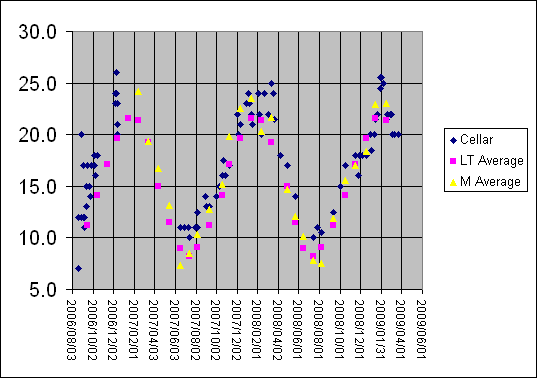
|
The blue diamond plots are temperatures measured in the cellar.
Pink squares are long-term average temperatures for Clare (PO).
Yellow triangles are average temperatures for that particular month
Note that recent months were warmer than average months (yellow plots are
above pink plots); evidence, if any more is needed, for global warming.
|
|
The cellar was built in late winter of 2006.
The door was first put in place in October (spring).
The maximum temperature I recorded in the cellar in
the first summer was 25 degrees (Celsius), while the outside temperatures
got into the low forties on a number of days.
This was before I had as much soil and vegetation cover on the roof as I
wanted.
As mentioned elsewhere, the temperature deep in the ground in my area is
18 degrees Celsius.
The temperature in the cellar on June 25th 2007 was 11 degrees;
outside the cellar, frosts were common.
The lowest temperatures recorded in the winters of 2007 and 2008 were 10
degrees.
I have made no attempt to heat the cellar, apart from letting the
afternoon sun shine in through the door, and leaving the wooden door open,
on some of the warmer days.
Typically, the temperature does not vary by more than a half a degree in
a day.
It is interesting to note that while the temperature in the summer of 2007
in the cellar was around 24-25 degrees for several months, it only got to
that level for a few days in 2008 (during the heatwave of late January
and early February).
The summer of 2007 was hotter for longer than that of 2008.
About half of the mulch and loam to go on the roof was placed within the
first three months; the other half went on gradually over the next couple
of years.
The fact that the increase in cover on top of the cellar seems to have made
little difference to temperatures within the cellar suggests that most of
the heat entering and exiting the cellar is via the door and exposed wall
near the door (see Vaulted entrance).
















